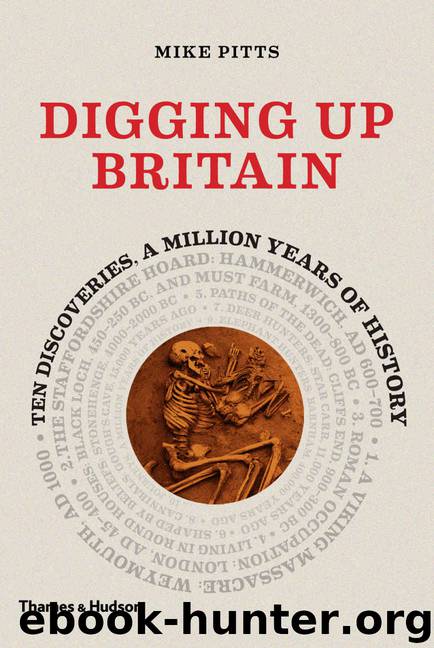Digging Up Britain: Ten Discoveries, a Million Years of History by Mike Pitts

Author:Mike Pitts [Pitts, Mike]
Language: eng
Format: azw3
Publisher: Thames & Hudson
Published: 2019-10-28T16:00:00+00:00
In recent years there has been an unprecedented amount of archaeological fieldwork around Stonehenge, much of it still under analysis. Our understanding of ancient landscapes is changing profoundly.
And nowhere, at certain times, was busier than Stonehenge.
Stonehenge’s original era of construction, use and rebuilding spanned the Late Neolithic and the Copper Age (3000–2200 BC), continuing into the Early Bronze Age (until 1500 BC). Inevitably during those fifty or sixty generations both the world and the monument changed. So can we see the one in the other?
One of the few apparently definitive claims about Stonehenge is that it began 5,000 years ago, before which there was nothing there to notice. Around 2900 BC people dug a perfectly circular enclosing ditch, a little over 100 metres across (350 feet) and threw the spoil up into a bank. It’s harder to date what went on inside, but by association we have long assumed that a slightly smaller concentric circle of Aubrey Holes (fifty-six large pits) was also dug at this time. The new consensus is that these pits probably held the first megaliths, relatively small bluestones from Wales.
The pits at Bulford, full of Grooved Ware, flints and animal bones, could be contemporary. These are the only ones of their kind investigated in recent times, but others were found in the last century with comparable hauls of selected and buried artefacts on the Avon’s west bank and on King Barrow Ridge, overlooking Stonehenge from the east. Something unusual was going on, but there is growing evidence that it wasn’t the beginning of it all.
While the ditch at Stonehenge is firmly radiocarbon-dated by tools used to dig it, made from red deer antler, other remains gave older dates. A few deer and cattle bones, including two ox jaws and an ox skull, date as far back as 3250 BC. Archaeologists have described these old bones as ‘curated’: they were collected from elsewhere and deliberately put in the ditch when it was dug. But where were they collected? The simplest answer would be more or less where they were found, some perhaps placed carefully in the ditch, some incorporated by accident. Stonehenge before Stonehenge.
One of the site’s defining features is a cremation cemetery, the largest of its kind known in prehistoric Britain. Though poor excavation records in the last century and the fact that much of Stonehenge remains unexcavated make it impossible to know exactly how large it was, there were probably a good two hundred burials, perhaps many more. The most recent radiocarbon date we have for one of these is about 2500 BC, and it has been assumed that the cemetery began when the Aubrey Holes were dug, where many of the burials are found.
In 2008 I was part of a team that re-excavated a huge mass of cremated human bone, first recovered at Stonehenge in the 1920s and reburied in an Aubrey Hole in 1935. We were surprised to find a previously unknown burial that had not been excavated before. The woman’s remains gave us a radiocarbon age of around 3000 BC.
Download
This site does not store any files on its server. We only index and link to content provided by other sites. Please contact the content providers to delete copyright contents if any and email us, we'll remove relevant links or contents immediately.
| Africa | Americas |
| Arctic & Antarctica | Asia |
| Australia & Oceania | Europe |
| Middle East | Russia |
| United States | World |
| Ancient Civilizations | Military |
| Historical Study & Educational Resources |
Life of Elizabeth I by Alison Weir(2026)
The Invisible Wall by Harry Bernstein(1765)
Art of Betrayal by Gordon Corera(1401)
1916 in 1966 by Mary E. Daly(1230)
Thunderstruck by Erik Larson(1181)
The Decline and Fall of the British Empire, 1781-1997 by Piers Brendon(1096)
A Brief History of Britain, 1066-1485 by Nicholas Vincent(1009)
A Brief History of Britain, 1485-1660 by Ronald Hutton(978)
Guy Burgess by Stewart Purvis(971)
Mary, Queen of Scots by Weir Alison(961)
Henry VIII by Alison Weir(909)
The Last Lion 02 - Winston Churchill - Alone, 1932-1940 by William Manchester(907)
Lang Lang by Lang Lang(833)
1066 by Andrew Bridgeford(829)
The Last Plantagenet by Thomas B Costain(810)
Gimson's Kings and Queens by Andrew Gimson(810)
Coalition by David Laws(806)
London: A Biography by Peter Ackroyd(803)
Diana by Andrew Morton(785)
